by Bruce Wells | May 8, 2025 | Petroleum Pioneers
Pennsylvania drillers kept oil production from the 1882 Warren County well a closely guarded secret.
Every year in densely wooded Cherry Grove, Pennsylvania, community members celebrate a 19th-century oil well and its place in American petroleum history. Led by local and visiting oil patch historians in June 2024, the Cherry Grove Old Home and Community Day featured tours of the well that once shook global petroleum markets.
When daily oil production from the “Mystery Well” was revealed in 1882, oil prices plunged worldwide. The discovery well drilled on lot 646 in the wilderness of Warren County had been a closely guarded secret. (more…)
by Bruce Wells | Apr 26, 2025 | Petroleum Technology
A two-wicked safety lamp for preventing “destructive conflagrations” on oil derricks.
Oil patch lore says “Yellow Dog” lanterns got their name because of two burning wicks that resembled a dog’s glowing eyes at night. Others say the lamps cast an eerie dog’s head shadow on the derrick floor.
Rare is the community oil museum that doesn’t have a Yellow Dog in its collection. Officially patented a decade after the Civil War, the two-wicked “Derrick Safety Lamp” would become an oilfield icon. But long before Yellow Dogs found their way to the oil patch, a similar design burned animal fat atop America’s lighthouses.
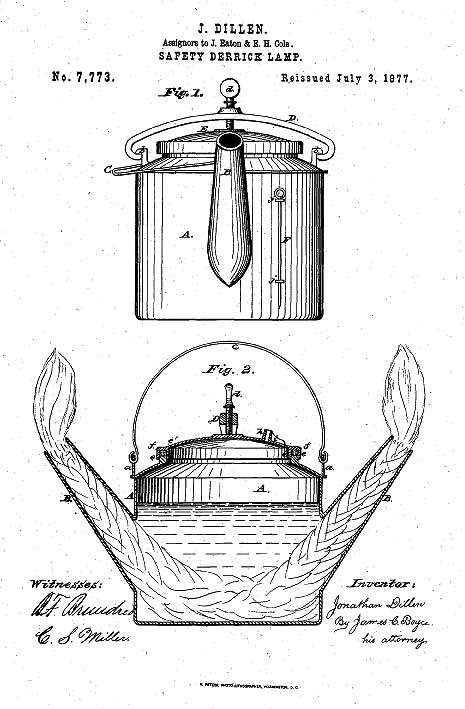
First patented in 1870, Jonathan Dillen’s lantern was “adapted for use in the oil regions…where the explosion of a lamp is attended with great danger by causing destructive conflagration and consequent loss of life and property.”
By the late 1700s, the cylindrical “Bucket Lamp” included two or four spouts protruding from its sides, according to Thomas Tag in Lighthouse Lamps Through Time. “Each spout carried a large diameter rope wick that extended down inside the body of the lamp into the oil.”
As late as 1874, four years after the Yellow Dog lamp’s patent, the U.S. Lighthouse Board of the Department of Treasury continued to mandate the use of lard for fueling the beacons, later rejecting electricity and natural gas because of “the complexity and cost of the apparatus.”

By 1877, the Lighthouse Board changed its illumination mandate to kerosene, which would be supplanted by electric arc lamps and followed by incandescent bulbs.
Inventing the Yellow Dog
Despite its many oilfield service manufacturers, the Yellow Dog’s origins remain in the dark. Some historical sources claim the derrick lamp’s design originated with the whaling industry, but neither the Nantucket nor New Bedford whaling museums have found any such evidence.
Railroad museums often include collections of cast iron smudge pots, but nothing approaching the heavy, crude-oil-burning lanterns once prevalent in oilfields from Pennsylvania to California.
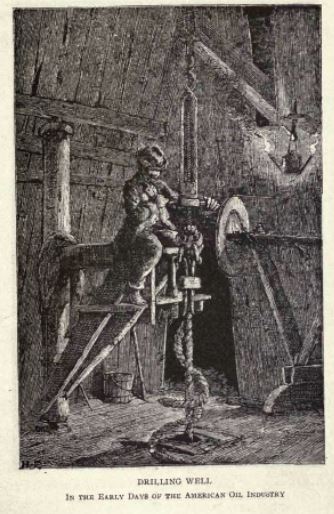
A 19th-century illustration of a cable-tool driller with his nearby Yellow Dog lantern.
Inventor Jonathan Dillen of Petroleum Centre, Pennsylvania, was first to patent what became the iconic lantern of the early years of the petroleum industry. His U.S. patent was awarded on May 3, 1870. The two-wicked lamp joined other safety innovations as drilling technologies evolved.
The lamp was designed “for illuminating places out of doors, especially in and about derricks, and machinery in the oil regions, whereby explosions are more dangerous and destructive to life and property than in most other places.”

“My improved lamp is intended to burn crude petroleum as it comes from the wells fresh and gassy,” Dillen proclaimed. “It is to be used, mainly, around oil wells, and its construction is such as to make it very strong, so that it cannot be easily broken or exploded.”
Dillen’s Yellow Dog patent was improved upon and reissued in 1872 and again in 1877 when it was assigned to a growing oilfield equipment supplier.
Oil Well Supply Company
In 1861, John Eaton made a business trip to the booming oil region of western Pennsylvania. Within a few years, he had set up his own business with Edward Cole. With the addition of Edward Burnham, the company grew to become a preeminent supplier of oilfield equipment.
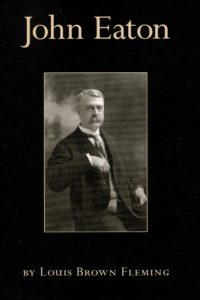
A John Eaton biography by his great-grandson notes Eaton was considered “the father of the well supply trade” of early Pennsylvania oilfields.
By 1877, Eaton, Cole & Burnham oilfield supply had outlets in the Pennsylvania oil regions, including Pittsburgh and Bradford. The company changed its name Oil Well Supply Company the next year, according to a biography by his great-grandson, Louis B. Fleming.
“The first goods manufactured by the Oil Well Supply Company were made on a foot lathe,” John Eaton would recall. The oilfield equipment supply company was operating 75 manufacturing plants by the turn of the 20th century.

The biography, John Eaton, by journalist Fleming, cited the classic 1898 book Sketches in Crude Oil, which noted that Oil Well Supply company’s founder and president “may fairly claim to be the father of the well supply trade.”
A Pennsylvania Historical and Museum Commission roadside marker erected in Oil City in 1992 notes: “Oil Well Supply Company — Founded nearby in 1878, it was a leading manufacturer of oil well machinery and supplies, serving the oil industry across the globe. By the early 1900s, employment peaked at 2,000. In 1930 it became a subsidiary of United States Steel.”

Incorporated in Pennsylvania — the Keystone State — Forest Oil’s logo features the iconic two-wicked lamp invented in 1870.
In Oil City at its 45-acre Imperial Works on the Allegheny River, Oil Well Supply manufactured oilfield engines and “cast and malleable iron goods” that included the two-wicked derrick safety lamp. The 1884 Oil Well Supply catalog listed Yellow Dog lamps at $1.50 each.
Today, along with their shadowy origins, the Yellow Dog lanterns are relegated to museums, antique shops and collectors. They sometimes can be found on display next to another unusual two-wicked lamp (see Camphene to Kerosene Lamps).
Forest Oil Company Logo
After experimenting with injecting water into some wells to increase production from others, Forest Dorn partnered with his father Clayton in 1916 to establish Forest Oil, an oilfield service company in Pennsylvania’s giant Bradford oilfield.
The company in February 1824 adopted the two-wicked oilfield derrick lamp as part of its logo, which included a keystone shape inside the lantern to symbolize the state of Pennsylvania — where the first commercial U.S. oil well was drilled in Titusville in 1859.

Forest Oil Company developed an extremely efficient technique for “secondary recovery” of trapped petroleum reservoirs. The waterflooding proved revolutionary for improving oilfield production nationwide. The technological leap began at America’s first giant oilfield, discovered in 1871 in Bradford, about 70 miles east of Titusville.

An oil museum near Bradford, Pennsylvania, educates visitors using a replica of an 1880s standard cable-tool derrick. Photo by Bruce Wells.
By 1916, oil production in the Bradford field had declined to just under 40 barrels a day. The reserve was considered by many to be dry — until Forest Dorn had applied his water-flooding technique to initiate secondary recovery of oil. Forest Oil became widely recognized as a leader in secondary oil recovery systems.
Water-flooding boosted oilfield production and arrived as demand for gasoline was growing (see Cantankerous Combustion – First U.S. Auto Show). The rapidly growing science of petroleum geology also led to more “secondary recovery” technologies.
Enhanced recovery would be applied throughout the petroleum industry, extending individual well production by 10 years — especially benefitting the already considerable production from the largest oilfield in the lower 48 states, the East Texas oilfield, discovered in 1930.
Oil Museums
The history of America’s “first billion-dollar oilfield” is on exhibit at the Penn-Brad Historical Oil Park and Museum near Bradford, Pennsylvania — where a modern natural gas shale boom has renewed the historic oil patch economy.

Located in Custer City, three miles south of Bradford (home of Zippo lighters), the museum (maintained by many dedicated volunteers) “preserves the philosophy, the spirit, and the accomplishments of an oil country community.”
One attraction of the Penn-Brad museum is its 72-foot standard cable-tool derrick and engine house, replicas of 1880s technology that helped Bradford once produce 74 percent of all U.S. oil. It’s another noteworthy stop among other excellent Pennsylvania oil museums a few hours west of Bradford at the Drake Well Museum in Titusville.
_______________________
Recommended Reading: Early Days of Oil: A Pictorial History of the Beginnings of the Industry in Pennsylvania (2000); Images of America: Around Bradford
(2000); Images of America: Around Bradford (1997); The Prize: The Epic Quest for Oil, Money & Power (1991). Your Amazon purchase benefits the American Oil & Gas Historical Society. As an Amazon Associate, AOGHS earns a commission from qualifying purchases.
(1997); The Prize: The Epic Quest for Oil, Money & Power (1991). Your Amazon purchase benefits the American Oil & Gas Historical Society. As an Amazon Associate, AOGHS earns a commission from qualifying purchases.
_______________________
The American Oil & Gas Historical Society (AOGHS) preserves U.S. petroleum history. Please become an AOGHS annual supporter and help maintain this energy education website and expand historical research. For more information, contact bawells@aoghs.org. © 2025 Bruce A. Wells. All rights reserved.
Citation Information – Article Title: “Yellow Dog – Oilfield Lantern.” Authors: B.A. Wells and K.L. Wells. Website Name: American Oil & Gas Historical Society. URL: https://aoghs.org/technology/yellow-dog-oil-field-lantern. Last Updated: April 22, 2025. Original Published Date: September 1, 2008.
by Bruce Wells | Apr 15, 2025 | Petroleum Technology
Ever since the earliest U.S. oil discoveries, detonating dynamite or nitroglycerin downhole helped increase a well’s production. The geologic “fracking” technology commonly used in oilfields after the Civil War would be significantly enhanced when hydraulic fracturing arrived in 1949.
Modern hydraulic fracturing — popularly known as petroleum well “fracking” — can trace its roots to April 1865, when Civil War Union veteran Lt. Col. Edward A. L. Roberts received the first of his many patents for an “exploding torpedo.” (more…)

by Bruce Wells | Apr 8, 2025 | Petroleum Art
Pennsylvania oilfield tragedy led to new safety and firefighting technologies — and a work of art.
The danger involved in America’s early petroleum industry was revealed when the first commercial well went up in flames just weeks after finding oil in the summer of 1859 — becoming the first oil well fire. More serious infernos would follow as the young industry’s early technologies struggled to keep up.
While the Pennsylvania oil region grew — and wooden derricks multiplied on hillsides — an 1861 deadly explosion and fire at Rouseville added urgency to the industry’s need for inventing safer ways for drilling wells.
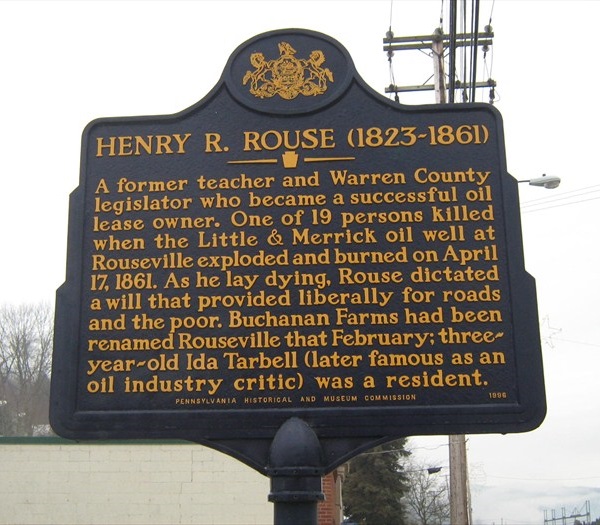
A marker was dedicated in 1996 on State Highway 8 near Rouseville by the Pennsylvania Historical and Museum Commission. Henry Rouse’s reputation made him a respected leader in the early oil industry.
On April 17, 1861, a highly pressurized well’s geyser of oil exploded in flames on the Buchanan Farm at Rouseville, killing the well’s owner and more than a dozen bystanders.
Sometimes called “Oil Well Fire Near Titusville” but more accurately, Rouseville, the early oilfield tragedy was overshadowed by the greater tragedy of the Civil War. Fort Sumter fell on April 13, 1861; Henry Rouse’s oil well exploded four days later.

The Little and Merrick well at Oil Creek, drilled by respected teacher and businessman Henry Rouse, unexpectedly had hit a pressurized oil and natural gas geologic formation at a depth of just 320 feet. Given the limited drilling technologies for controlling the pressure, the well’s production of 3,000 barrels of oil per day was out of control.
The Rouse Estate later reported, “A breathless worker ran up to him, telling him to ‘come quickly’ as they’d ‘hit a big one.’ According to the best accounts of the time, the ‘big one’ was the world’s first legitimate oil gusher. As oil spouted from the ground, Henry Rouse and the others stood by wondering how to control the phenomenon.”
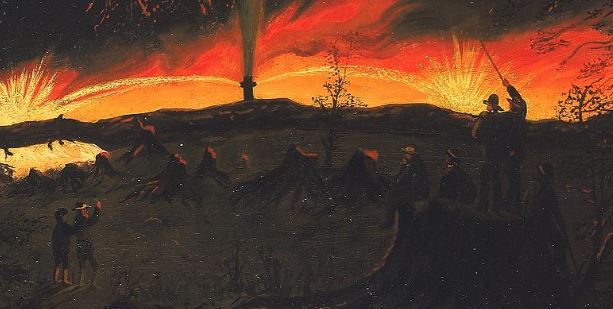
Detail from “Burning Oil Well at Night, near Rouseville, Pennsylvania,” a painting by James Hamilton of the 1861 oil well fire that killed Henry Rouse today is in the collection of the Smithsonian American Art Museum, Washington, D.C.
The towering gusher also had attracted people from town; many had become covered with oil. Perhaps ignited by the steam engine’s boiler, the well suddenly erupted into flames that engulfed Rouse, killing him and 18 others and seriously burning many more.
Historian Michael H. Scruggs of Pennsylvania State University found a dramatic account from an eyewitness, who reported:
“One of the victims it would seem had been standing on these barrels near the well when the explosion occurred; for I first discovered him running over them away from the well. He had hardly reached the outer edge of the field of fire when coming to a vacant space in the tier of barrels from which two or three had been taken, he fell into the vacancy, and there uttering heart-rending shrieks, burned to death with scarcely a dozen feet of impassable heated air between him and his friends.”
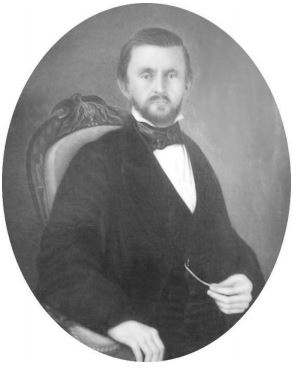
Henry R. Rouse, 1823-1861.
Scruggs noted the 37-year-old Henry Rouse was dragged from the fire severely burned, and expecting the worst, dictated his Last Will and Testament, “to the men surrounding him as they fed him water spoonful by spoonful.”

Engraved on an 1865 marble monument (re-dedicated to Rouse’s memory during a family reunion in 1993) is this tribute:
Henry R. Rouse was the typical poor boy who grew rich through his own efforts and a little luck. He was in the oil business less than 19 months; he made his fortune from it and lost his life because of it. He died bravely, left his wealth wisely, and today is hardly remembered by posterity. — from the Rouse Estate.
The 1865 Atlas of the Oil Regions of Pennsylvania by Frederick W. Beers described this early petroleum industry tragedy in detail:
It was upon this farm (Buchanan) that the terrible calamity of April 1861, occurred, when several persons lost their lives by the burning of a well. The “BURNING WELL” as it has since been called, had been put down to the depth of three hundred and thirty feet, when a strong vein of gas and oil was struck, causing suspension of operations and ejecting a stream from the well as high as the top of the derrick.
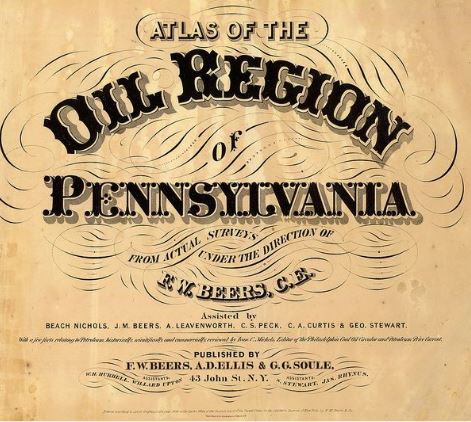
“Atlas of the Oil Regions of Pennsylvania,” published by Frederick W. Beers in 1865.
Large numbers of persons were attracted to the scene, when the gas filling the atmosphere took fire, as is supposed, from a lighted cigar, and a terrible explosion ensued, which was heard for three or four miles. The well continued to burn for upwards of twenty hours destroying the tanks and machinery of several adjacent wells, and several hundred barrels of oil. The scene is represented as terrific beyond comparison.
The well spouted furiously for many hours, and the column of flame extended often two and three hundred feet in height, the valley being shut in, as it were, by a dense and impenetrable canopy of overhanging smoke. Fifteen persons were instantly killed by the explosion of the gas, and thirteen others scarred for life.

Among the persons killed was Mr. Henry R. Rouse, who had then recently become interested in that locality, and after whom Rouseville takes its name. The well continued to flow at the rate of about one thousand barrels per day for a week after the fire, when it suddenly ceased, and has since produced very little oil as a pumping well.
These fires have not been unfrequent, and it is a little remarkable that in every case where wells have been so burned they have never after produced save in very small quantities.
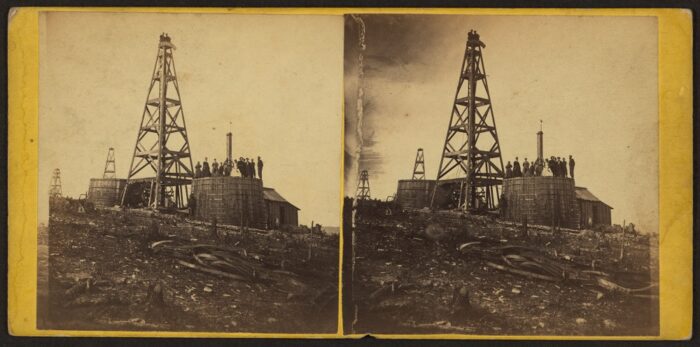
Late 1860s stereograph by William J. Portser showing men and women standing on a storage tank and two men at the top of an oil derrick in Pennsylvania, courtesy Library of Congress.
According to historian Scruggs, the knowledge gained from the 1861 disaster along with other early oilfield accidents brought better exploration and production technologies. The first “Christmas Tree” — an assembly of control valves – was invented by Al Hamills after the 1901 gusher at Spindletop Hill, Texas.
Although the deadly Rouseville well fire caused tragedy and devastation, “the knowledge gained from the well along with other accidents helped pave the way for new and safer ways to drill,” Scruggs wrote in his 2010 article.
“These inventions and precautions have become very important and helpful, especially considering many Pennsylvanians are back on the rigs again, this time drilling for the Marcellus Shale natural gas,” he concluded.
Learn more about another important invention, Harry Cameron’s 1922 blowout preventer in Ending Gushers – BOP.
Oil Well Fire at Night
The tragic Pennsylvania oil well fire was immortalized by Philadelphia artist James Hamilton, a mid-19th century painter whose landscape and maritime works are in collections of the Metropolitan Museum of Art in New York City, the Tate Gallery in London, and the Smithsonian American Art Museum (SAAM) in Washington, D.C.

Acquired by the Smithsonian American Art Museum in 2017, artist James Hamilton’s “Burning Oil Well at Night, near Rouseville, Pennsylvania,” was on display in 2018. Photo by Bruce Wells.
In 2017, the Smithsonian museum acquired Hamilton’s “Burning Oil Well at Night, near Rouseville, Pennsylvania,” circa 1861 (oil on paperboard, 22 inches by 16 1⁄8 inches, currently not on view).
“Rouseville, Pennsylvania, lay within a few miles of Titusville and Pithole City, two of the most famous boom towns in Pennsylvania ’s oil fields,” noted the museum’s 2017 description of the painting.

“From 1859 until after the Civil War, new gushers brought investors, cardsharps, saloons, and speculators into these rural settlements. As quickly as they grew, however, the towns collapsed, often from the effects of fires like the one shown here,” noted the Smithsonian’s description.
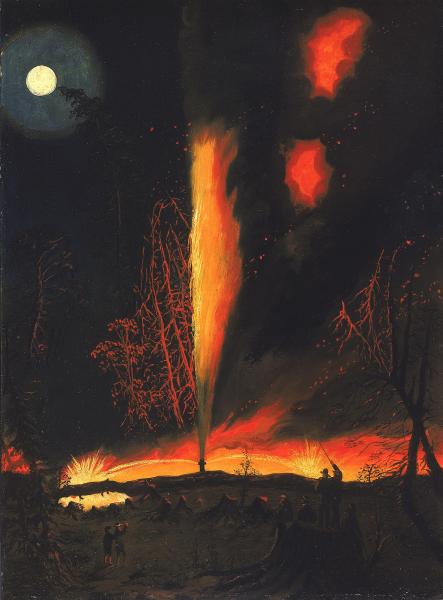
Flames shooting from the wellhead are part of the circa 1861 “Burning Oil Well at Night, near Rouseville, Pennsylvania,” by James Hamilton.
“In the 1860s, American industrialist John D. Rockefeller (1839-1937) was in the thick of this oil boom, maneuvering to establish the Standard Oil Company,” the museum’s painting description added. “Rockefeller’s investments in railroads and refineries would make him one of America’s richest men, long after the wildcatters in the Pennsylvania fields had gone bust.”
Famed journalist and Rockefeller antagonist Ida Tarbell lived in Rouseville as a child.
Following the Civil War, with consumers increasingly demanding kerosene for lamps (and soon gasoline for autos), the search for oilfields moved westward. The young petroleum industry also developed safety and accident prevention methods alongside new oilfield firefighting technologies.
_______________________
Recommended Reading: Trek of the Oil Finders: A History of Exploration for Petroleum (1975); Atlas of the oil region of Pennsylvania (1984); Cherry Run Valley: Plumer, Pithole, and Oil City, Pennsylvania (2000); Warren County (2015). Your Amazon purchase benefits the American Oil & Gas Historical Society. As an Amazon Associate, AOGHS earns a commission from qualifying purchases.
_______________________
The American Oil & Gas Historical Society (AOGHS) preserves U.S. petroleum history. Please become an AOGHS supporter and help maintain this energy education website and expand historical research. For more information, contact bawells@aoghs.org. © 2025 Bruce A. Wells. All rights reserved.
Citation Information: Article Title: “Fatal Oil Well Fire of 1861.” Authors: B.A. Wells and K.L. Wells. Website Name: American Oil & Gas Historical Society. URL: https://aoghs.org/petroleum-pioneers/first-oil-well-fire. Last Updated: April 12, 2025. Original Published Date: April 29, 2013.
by Bruce Wells | Apr 7, 2025 | This Week in Petroleum History
April 7, 1902 – Spindletop Boom brings The Texas Company –
Joseph “Buckskin Joe” Cullinan and Arnold Schlaet established The Texas Company in Beaumont to transport and refine oil from Spindletop Hill, a giant oilfield discovered in January 1901. The new company constructed a kerosene refinery in Port Arthur — and discovered an oilfield at Sour Lake Springs, where its Fee No. 3 well produced 5,000 barrels of oil a day in 1903.

The National Route 66 Museum in Elk City, Oklahoma, preserves the heritage of Texaco, the first petroleum company to market products in all 50 states. Photo by Bruce Wells.
The Texas Company telegraph address at its New York office was “Texaco,” a name soon adopted for its petroleum products. In 1909 a red star with a green capital “T” was trademarked and by 1928 the Texaco brand operated more than 4,000 service stations nationwide. The Texas Company, which officially renamed itself Texaco in 1959, was acquired by Chevron in 2001.
Learn more in Sour Lake produces Texaco.

April 7, 1966 – Cold War Accident boosts Offshore Technology
A robotic technology soon adopted by the offshore petroleum industry was first used to retrieve an atomic bomb. America’s first cable-controlled underwater research vehicle (CURV) attached cables to recover the weapon lost in the Mediterranean Sea.
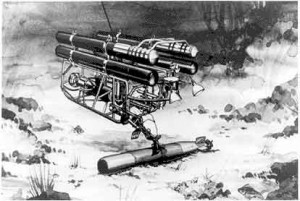
The U.S. Navy in 1966 used its CURV (Cable-Controlled Underwater Recovery Vehicle) to recover a lost nuclear bomb in the Mediterranean.
The 70-kiloton hydrogen bomb, which had been lost when a B-52 crashed off the coast of Spain in January, was safely hoisted from a depth of 2,850 feet.
“It was located and fished up by the most fabulous array of underwater machines ever assembled,” proclaimed Popular Science magazine. During the Cold War, the Navy developed deep-sea technologies that the offshore petroleum industry would adopt and continue to advance.
Learn more in ROV – Swimming Socket Wrench.
April 8, 1929 – Sinclair vs. United States
The Supreme Court unanimously upheld a lower court ruling that Congress had the right to investigate Sinclair Oil founder Harry Sinclair’s personal dealings with Secretary of the Interior Albert Fall regarding the leasing of federal oil reserves. In 1922, Fall had leased land in the Teapot Dome oilfield (Navy Reserve No. 3) to the Mammoth Oil Company, a Sinclair subsidiary. He also leased land in California’s Elk Hills reserve to Edward Doheny, the 1892 discoverer of the Los Angeles Field.
After several trials, proceedings concluded with Doheny being acquitted of conspiracy and Fall convicted of accepting bribes and serving nine months in prison, notes the Federal Judicial Center. He was the first cabinet official to go to prison. Sinclair was acquitted of conspiracy but convicted of contempt of Congress and served six and a half months in prison in 1929.
April 9, 1914 – Ohio Cities Gas Company founded
Beman Dawes and Fletcher Heath organized the Ohio Cities Gas Company in Columbus, Ohio, before building an oil refinery in West Virginia. Ohio Cities Gas acquired Pennsylvania-based Pure Oil Company in 1917 and adopted that name three years later. Pure Oil was founded in Pittsburgh in 1895 by independent oil producers, refiners, and pipeline operators to counter the market dominance of Standard Oil Company.

Ohio Cities Gas Company became Pure Oil in 1917.
By producing, refining and selling its products, Pure Oil became the second vertically integrated petroleum company after Standard Oil. Headquartered in a now iconic Chicago skyscraper it built in 1926, the company joined the 100 largest U.S. industrial corporations. It was acquired in 1965 by Union Oil Company of California, now a division of Chevron.
April 9, 1966 – Birthday of Tula’s Golden Driller
A 76-foot statue of an oilfield worker today known as “The Golden Driller” made its debut at the International Petroleum Exposition in Tulsa, Oklahoma. After several refurbishments, the 22-ton statue would contain 2.5 miles of rods and mesh with tons of plaster and concrete — withstanding winds up to 200 mph. A smaller version of Tulsa’s iconic roughneck originally appeared at the 1953 petroleum exposition as a promotion for the Mid-Continent Supply Company of Fort Worth, Texas.
April 10, 1866 – Densmore Brothers patent Railroad Oil Tank Car
James and Amos Densmore of Meadville, Pennsylvania, received a patent for their “Improved Car for Transporting Petroleum,” developed a year earlier in the northwestern Pennsylvania oil regions. Their patent illustrated a simple but sturdy design for securing two re-enforced containers on a typical railroad car.
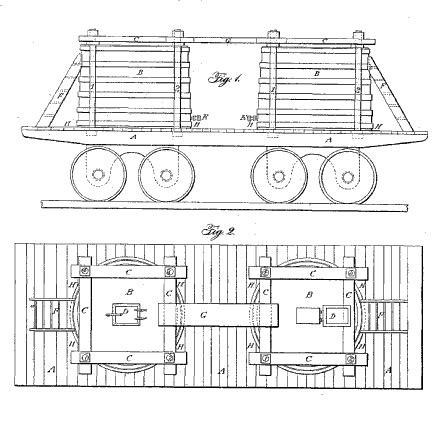
The Densmore dual tank car briefly revolutionized the bulk transportation of oil to market. Hundreds of the twin tank railroad cars were in use by 1866.
Although the Densmore cars were an improvement, they would be replaced by the more practical single, horizontal tank. After leaving the business, Amos Densmore in 1875 invented a new way for arranging “type writing machines” so commonly used letters would not collide — the “Q-W-E-R-T-Y” keyboard. James Densmore’s continued success in oilfields helped finance the start of the Densmore Typewriter Company.
Learn more in Densmore Brothers invent First Oil Tank Car.
April 11, 1957 – Independent Producer William Skelly dies
William Grove Skelly (1878 -1957) died in Tulsa after a long career as an independent producer he began as a 15-year-old tool dresser in early Pennsylvania oilfields. Prior to World War I, he found success in the El Dorado field outside Wichita, Kansas. Skelly incorporated Skelly Oil Company in Tulsa in 1919. In 1923, Skelly organized the first International Petroleum Exposition while serving as president of the Tulsa Chamber of Commerce. Skelly in 1947 helped establish KWGS, Tulsa’s first FM radio station and one of the earliest educational stations in the nation.

April 13, 1974 – Depth Record set in Oklahoma Anadarko Basin
After drilling for 504 days and spending about $7 million, the Bertha Rogers No. 1 well reached a total depth of 31,441 feet (5.95 miles) before being stopped by liquid sulfur. Drilled in Oklahoma’s Anadarko Basin, it held the record of the world’s deepest well for more than a decade.
The GHK Company of Robert Hefner III and partner Lone Star Producing Company believed natural gas reserves resided deep in the Anadarko Basin extending across West-Central Oklahoma and the Texas Panhandle. Their first high-tech drilling attempt began in 1967 and took two years to reach a then record depth of 24,473 feet.

A 1974 souvenir plaque of the Bertha Rogers No. 1 well, which reached almost six miles deep in Oklahoma’s Anadarko Basin.
The 1969 well found plenty of natural gas, according to historian Robert Dorman, but because of federal price controls, “the sale of the gas could not cover the high cost of drilling so deeply – $6.5 million, as opposed to a few hundred thousand dollars for a conventional well.”
The drilling of the Bertha Rogers well began in November 1972 and averaged about 60 feet per day. By April 1974, bottom-hole pressure reached almost 25,000 pounds per square inch with a temperature of 475 degrees. The well’s 1.5 million pounds of casing was the heaviest ever handled by a drilling rig, and it took eight hours for cuttings to reach the surface.
Learn more in Anadarko Basin in Depth.
_______________________
Recommended Reading: The Texaco Story: The First Fifty Years, 1902-1952 (2012); Mapping the Deep: The Extraordinary Story of Ocean Science
(2012); Mapping the Deep: The Extraordinary Story of Ocean Science (2002); Diving & ROV: Commercial Diving offshore (2021); The American Railroad Freight Car (1995); Story of the Typewriter, 1873-1923 (2019); Tulsa Where the Streets Were Paved With Gold – Images of America
(2002); Diving & ROV: Commercial Diving offshore (2021); The American Railroad Freight Car (1995); Story of the Typewriter, 1873-1923 (2019); Tulsa Where the Streets Were Paved With Gold – Images of America (2000); Oil in Oklahoma
(2000); Oil in Oklahoma (1976); History Of Oil Well Drilling
(1976); History Of Oil Well Drilling (2007). Your Amazon purchase benefits the American Oil & Gas Historical Society. As an Amazon Associate, AOGHS earns a commission from qualifying purchases.
(2007). Your Amazon purchase benefits the American Oil & Gas Historical Society. As an Amazon Associate, AOGHS earns a commission from qualifying purchases.
_______________________
The American Oil & Gas Historical Society (AOGHS) preserves U.S. petroleum history. Please become an AOGHS annual supporter and help maintain this energy education website and expand historical research. For more information, contact bawells@aoghs.org. Copyright © 2025 Bruce A. Wells. All rights reserved.





















